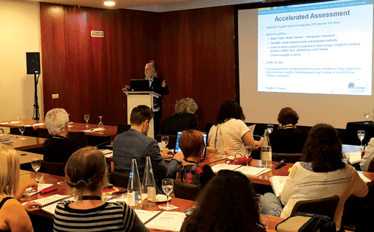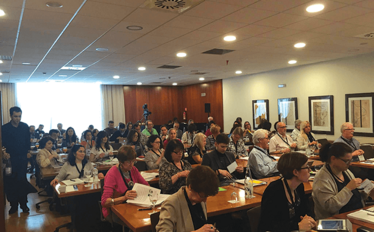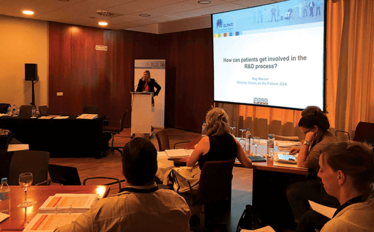
The Missing Piece of the Puzzle
Patients are a central component of medical research – so why aren’t their voices always heard? As a fellow of the European Patients’ Academy, I invite you to begin a proper two-way dialog with your research participants – you may be surprised when you both learn something new…
At a Glance
- It can be difficult for patients and professionals to connect across language and knowledge barriers
- As a result, medical research may not be fully informed – or may not actually be tailored to the needs of the patients dealing with disease
- Resources like expert training and online toolboxes can help educate patients to communicate with researchers and healthcare professionals on an equal footing
- Professionals also need to reach out to patients, treat them as partners, and make their work accessible
A few years ago, medical researchers in many fields began to realize that they faced a significant knowledge gap: they didn’t know what patients actually experienced. But how could they find out? Talking to patients was an obvious solution, but most patients don’t understand how biomedical science works. There’s no common language between the laymen and the laboratory, and it’s hard for either group to determine what the other may find useful.
Though it seemed like an insurmountable obstacle at first, the European Union decided to step in. Through the Innovative Medicines Initiative and the European Federation of Pharmaceutical Industries and Associations, the EU launched a massive five-year initiative to train patient advocates in all aspects of medicine research and development. The result? EUPATI – the European Patients’ Academy.
EUPATI offers a number of services, but its most recognizable is its “school.” The Patient Expert Training Course is a 14-month program that includes both e-learning modules and face-to-face events. After they graduate, students become EUPATI fellows and serve as resources for both patients and researchers.
When I was first diagnosed with primary sclerosing cholangitis (PSC), a rare liver disease, I couldn’t find much accessible information in my native language. I knew right away that I wanted to do more to help tackle my disease – and what I figured out is that we needed to change a lot from the patient’s perspective. Researchers and medical professionals can access academic papers and contact colleagues, but what can a recently diagnosed patient with no scientific training do? We need to be brought into the fold, so to speak, because we have a lot to learn to really understand our own diseases and the research surrounding them – but we also have a lot to teach healthcare professionals who have never experienced these diseases themselves. Collaboration is key, and if patients are to be equal partners at the negotiation table, we need to understand things at a professional level. With that in mind, I asked around, and someone told me about the Patient Expert Training Course, which was quite new at the time. I applied right away and was accepted. Through my education, I’ve become a much better participant in my own health care, as well as an advocate for the research and treatment of others.
Expert education
The program kicks off with six online modules that students work through from home – a convenient arrangement, as learning can be scheduled around treatment and other activities! The e-learning system also includes a forum where students can ask questions. When I took the course, there were three specialists assigned to each module, so we had access to researchers, pharmaceutical representatives and patient advocates who could answer our questions 24/7. While working on the e-learning component of the course, students also have two face-to-face sessions that encompass four consecutive full days of training with experts – mine took place in Barcelona. One especially interesting aspect was the role-play sessions; we pretended to be in a situation within the European Medical Agency’s Pharmacovigilance Risk Assessment Committee meeting; one person played the patient, another a relative, a third the regulatory representative, and so on. That kind of hands-on training gave us a really good feel for the different positions people hold and their duties within their organizations. It also made me a better participant in research groups, and it gave me the ability to anticipate and address potential areas of miscommunication before problems arise.
Getting started
In the beginning, it was a bit daunting because I wasn’t familiar with the vocabulary that the experts use (especially as I wasn’t working in my mother tongue). I think the medical field may use more abbreviations than any other! But the e-learning modules really helped me to get a grip on the things I found most difficult. They were so well-organized that I could walk myself through them one step at a time – and for patients who want to know more, every chapter includes not only a self-test, but also extra reading in case you want to learn about a topic in greater depth.
I think the format of the course really helps students feel like they’re part of a group, despite the fact that most of it is held online. Even though I was alone in my room, the modules made learning easy – and I always had the opportunity to ask questions, which was great. The forum was my favorite part of the course; I really appreciated being able to get clarification when I was confused, and I liked the fact that I could sometimes help other students who were struggling with questions of their own. In fact, I had a better experience with the online forum than I did attending university classes in person, because the commitment of the experts was obvious. Whenever I asked anything, I always got an answer within 24 hours!
A toolbox for training
EUPATI offers an excellent online toolbox (eupati.eu), which allows patients to search for any topic – and the resources are all available in seven languages, with more on the way. So even people who can’t commit to the whole training course can prepare themselves as a patient representative by going through the toolbox. Of course, for patients who do want the whole package, all of the expert training course modules are available for download – you don’t get the “group feeling” or the real-time access to experts if you go through the course yourself, but other than that you can study as much as you like on your own time.
My advice to researchers and laboratory medicine professionals is to be a little more sensitive to patients’ needs – whether experts or otherwise. You can point your patients or research participants to the training toolbox and other resources and encourage them to educate themselves. You can also make yourselves accessible to them, so that they feel comfortable coming to you with questions. You never know when you may both learn something new! Another key way to help is by treating patients and patient advocates as equal partners at the negotiation table. Even if they don’t have a pile of medical degrees, they’re certainly well-versed in their own conditions!
The most important thing is to get patients involved from day one. As a researcher, you might have a brilliant idea for something to study – but you might find that it’s not a priority for the patients themselves. By working as a team from the start, you can encourage patients to add their views to your own ideas and learn things that – as a non-patient – you’d have no other way of knowing. For instance, I once had a conversation with 17 other PSC patients; one of them mentioned that he had a milk intolerance... and all the other 16 said they had the same issue! I was telling the story to a researcher and his eyes started to twinkle. He said, “Marleen, I need to know these things. I’ve been in the lab for 30 years – and I’ve never met a PSC patient!” For me, that was pretty shocking. But it just goes to show that professionals and patients can actually help one another identify research priorities and get all of the stakeholders involved in the work.
In my experience, if you invest a little time in these kinds of activities, it will come back to you tenfold by making your collaborations and studies much easier – and often much better as well.
Do you know a suitable patient for expert training?
Who?
Patients with chronic or lifelong conditions, caregivers of such patients, or employees and volunteers with patient organizations. Participants must live in the European Region, speak English, and have an interest in and a desire to be involved with medical research.
What?
A 14-month training course consisting of six e-learning modules (250 study hours) and two five-day face-to-face meetings. The course is fully funded by IMI and EFPIA.
Where?
The online lessons can be taken in the participant’s home. The face-to-face meetings are conducted in Barcelona.
When?
Applications must be received by March 31, 2017. The course itself runs from September 2017 to December 2018, with face-to-face meetings in March and September 2018.
How?
Patients can apply at: eupati.eu/third-cycle-apply-now
Why?
“As a researcher, not having to explain what a Petri dish is, or what pharmacovigilance is, makes communication with patients much easier. It’s also more interesting for research and healthcare professionals to talk to informed patients for additional insight into the diseases they’re studying.”
“I think the biggest benefit for me as a patient is that I now know the vocabulary. I understand what the professionals are talking about. And if I have a question, I know how to find an answer.”
The communication challenge
There’s also great value in interacting with patients outside the research context. Many organizations have Facebook pages, which basically means that you have indirect access to those patients and their caregivers 24/7. You can see trends as they happen. For instance, the only possible treatment for PSC is a liver transplant. In the PSC groups on social media, you can read about the difficulties friends and family members face when their loved ones are on the waiting list; you see people deteriorate without having the ability to intervene. But on the other hand, when a patient gets “the call” or has an “anliversary” (marking the anniversary of a transplant), it’s a very special experience – and everyone in the group celebrates alongside them.
You also find out about the “little things” by interacting regularly with patients. To give you another PSC example, there is “the itch.” Most PSC patients suffer tremendously from itching, but there’s no way to cure it. Anti-itching medication exists, of course, but it doesn’t significantly affect the cholestatic itch. So if you are a researcher who wants to study the itch, talking to patients first will help you understand exactly which itch they want to have studied and how and why it impacts their lives. Not only will that give you more information for your work and potentially improve your chances of finding funding, but it might also add some motivation from a personal angle.
I think there’s a lot of value in talking to patients about your research – but I think there’s equal value in making your work accessible to them after it’s complete. When you publish the results of your study, you can add a “lay version” so that the participants in your trial, and the disease community at large, can also find out what you discovered. It makes everyone part of a larger community, and I think that’s very beneficial.
I would go as far as to say that, if you don’t have a patient expert on your team – both to help guide your work and to help you make it accessible to other patients – you’re missing a whole array of opportunities to advance medicine.
Finding – and working with – patient experts
The best way to begin your search for a patient expert is to consult with the patient organizations in your country – or, if there aren’t any, the international associations. For instance, for liver diseases, we have the European Association for the Study of the Liver. It always starts with finding a patient organization, because then you can contact them to ask for a patient panel; request support with writing a lay version of your research; get assistance seeking funding for your project. The opportunities are almost limitless!
A word of caution: you need to make sure you’re actually speaking with the patients themselves; sometimes, patient organizations provide people who claim to know everything about a particular disease, but don’t actually have it themselves. In the Netherlands, we call those people “office patients.” If you’re not a patient yourself, you don’t know what it’s like to have a chronic illness, no matter how much experience you have.
I always start by asking researchers, “What can I do for you?” They are always very surprised, because the old-school approach is for the patient to dictate what he or she wants, and the researchers to try to cater to it. I turn it around by asking what I can do to help them. The first thing they say most of the time is that they need money – and I say, “That’s important, but let’s not talk money right now. If we have a good enough plan, the money will come.” Then they say, for instance, that they want to do research, but don’t know where to find a patient population. That I can help with! “Did you know that I help moderate a Facebook group of 400 patients and caregivers?” Or they’ll tell me what they want to research – and it turns out to be something that isn’t a high priority for most patients. “Our research priorities are actually X, Y and Z. Here are the results of a pan-European survey we conducted in six languages.” When researchers know what’s really bothering patients – whether it’s something as obvious as transplant success rates or as subtle as needing too much sleep – it enables them to focus their work so that it has the greatest benefit for the patient community.
Of course, patients and professionals are attacking diseases from two very different angles. We can’t always expect the two groups to have identical goals, but we can encourage open communication by asking researchers and clinical professionals to make their work accessible to patients, and by asking patients to educate themselves as much as possible in how to be a useful participant in the research. If we can learn to meet in the middle and treat one another as equals, we’ll be well on our way to defeating these challenging conditions.
Marleen Kaatee is the founding President of PSC Patients Europe and a fellow of the EUPATI Patient Expert Training Course.
Marleen Kaatee is the founding President of PSC Patients Europe and a fellow of the EUPATI Patient Expert Training Course.


















